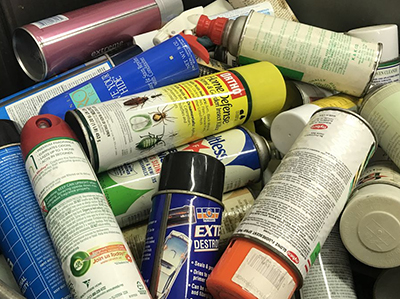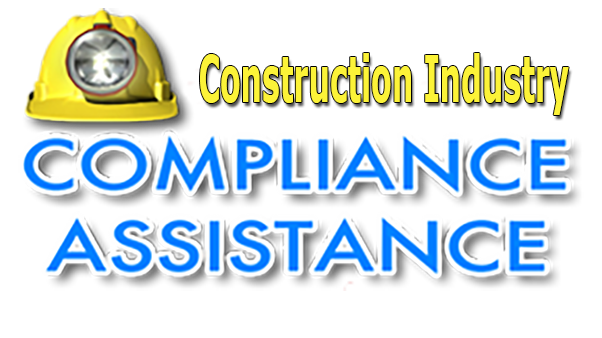
Aerosol Can Universal Waste Rule
 |
On December 9, 2019, the U.S. Environmental Protection Agency (EPA) finalized a rule to add aerosol cans to the federal universal waste program to provide an alternative, streamlined standard to manage widely generated hazardous wastes. Examples of wastes in the federal universal waste program include certain batteries, pesticides, lamps, and mercury-containing equipment. The addition of aerosol cans to the program brings in another common waste stream: an estimated 3.75 billion were filled in the United States in 2016. However, since the rule is less stringent than the prior program, it is not immediately in effect nationwide. Instead, states need to adopt the rule. See the rule language at https://www.govinfo.gov/content/pkg/FR-2019-12-09/pdf/2019-25674.pdf.
What are aerosol cans? For the purpose of this regulation, the agency defines aerosol cans consistent with the U.S. Department of Transportation as a non-refillable receptacle containing a gas compressed, liquefied or dissolved under pressure, the sole purpose of which is to expel a liquid, paste, or powder and fitted with a self-closing release device allowing the contents to be ejected by the gas.
Aerosol cans frequently contain flammable propellants such as propane or butane, which can cause aerosol cans to demonstrate the hazardous characteristic of ignitability. They may also have contents that exhibit hazardous characteristics or contain listed hazardous wastes.
What are the benefits of adding aerosol cans to the universal waste regulations?
Ease regulatory burden on generators
- Because aerosol cans managed under the final rule are not counted toward a facility’s RCRA Generator Status, Respondents will see a reduction in burden.
- Aerosol cans will not be subject to hazardous waste manifest requirements or recordkeeping and reporting requirements as hazardous waste
Promote recovery and recycling of the cans
- Facilitate environmentally sound recycling of the metal used to make the cans
- Reduce the quantity of these wastes going to municipal solid waste landfills or combustors.
Aerosol Universal Waste Management
Small quantity handlers of universal waste and large quantity handlers of universal waste must follow an aerosol universal waste management protocols. (Small quantity handlers of universal waste accumulate less than 5,000 kg of universal waste; large quantity handlers of universal waste accumulate 5,000 kg or more of universal waste.) Both large quantity handlers and small quantity handlers must comply with the following requirements:
- Labeling and Marking – labeled or marked clearly with any of the following phrases: Universal Waste – Aerosol Cans, Waste Aerosol Cans, Used Aerosol Cans
- Handlers may sort aerosol cans by type and consolidate intact aerosol cans in large containers, remove actuators to reduce the risk of accidental release.
- Accumulation Time Limits (1 year)
- Employee Training
- Responses to Releases – Handlers must manage their universal waste aerosol cans in a manner designed to prevent releases to the environment in containers that are structurally sound and compatible with the contents of the aerosol cans, lacks evidence of leakage, spillage, or damage that could cause leakage under reasonably foreseeable conditions, and is protected from sources of heat.
- Export Requirements
In addition, large quantity handlers must obtain an EPA ID number and maintain a copy of basic shipping records.
Note: Households that generate waste aerosol cans are exempt from the Federal Hazardous Waste management requirements. VSQGs (less than or equal to 100kg of haz waste in a calendar month) can opt to manage the waste as a VSQG or treat it as universal waste.
Puncturing
While puncturing and draining an aerosol can is not required under the universal waste rule, under certain conditions handlers may puncture and drain aerosol cans when the emptied cans are to be recycled. Aerosol cans that have been emptied of their contents (both propellant and product) would not be subject to the hazardous waste requirements or universal waste requirements when recycling as scrap metal – 40 CFR 261.6 (a)(3)(ii). The rule only allows for puncturing of cans on the condition that the empty punctured aerosol cans be recycled and the following management conditions are met:
- Conduct puncturing and draining activities using a device specifically designed to safely puncture aerosol cans and effectively contain the residual contents and any emissions
- Establish and follow a written procedure detailing how to safely puncture and drain the universal waste aerosol can (including proper assembly, operation and maintenance of the unit, segregation of incompatible wastes, and proper waste management practices to prevent fire and releases); maintain a copy of the manufacturers specification and instruction on site; and ensure employees operating the device are trained in the proper procedures.
- Ensure that puncturing of the can is done in a manner designed to prevent fires and to prevent the release of any component of universal waste to the environment. This manner includes, but is not limited to, locating the equipment on a solid, flat surface in a well-ventilated area.
- Immediately transfer the contents from the waste aerosol can or puncturing device, if applicable, to a container or tank that meets the applicable requirements.
- Segregate incompatible waste.
- Conduct a hazardous waste determination on the contents of the emptied aerosol can. If hazardous, the handler is considered the generator of hazardous waste and is subject to 40 CFR part 262. If found to be non-hazardous, the handler may manage the waste in any way that is in compliance with applicable solid waste regulations.
- Ensure containers are structurally sound, compatible with contents of the aerosol cans, lack evidence of leakage, spillage, or damage that could cause leakage under reasonable foreseeable conditions, and is protected from sources of heat.
- Have a written procedure in place in the event of a spill or leak and provide a spill cleanup kit. All spills or leaks of the contents of the aerosol cans must be cleaned up promptly.
Puncturing Tips from Contractors
- Train staff to perform puncturing safely.
- Check safe practices via audits.
- Rotate staff to minimize possible exposures.
- Ground the can punch system.
- Change filters when needed: per number of cans or use colorimetric filters.
Is Puncturing Cheaper?
How do you determine whether to puncture and recycle aerosol cans? While the universal waste rules remove aerosol cans from being counted towards a company’s hazardous waste generator status, non-empty aerosol cans must still be sent to a hazardous waste treatment, storage, disposal or recycling facility. For some contractors, reducing the volume of waste shipped to hazardous waste facilities by puncturing and draining the cans and recycling the emptied cans may lower overall waste management costs. (Note that the contents collected from punctured aerosol cans are not universal waste and would be subject to a hazardous waste determination). For others, the cost of setting up a puncturing area and managing the contents removed from punctured cans as hazardous waste may be cost prohibitive for the benefit they would obtain from processing a low number of aerosol cans. To help you make a decision, contractors have shared examples of some of the costs that you will need to consider.
Scenario Option 1: Disposal (prices are estimates provided for example only)
- Approximately 234 aerosol cans fit into a 55 gallon drum and the cost for transportation/disposal is approximately $500.
Scenario Option 2: Puncturing (prices are estimates provided for example only)
- If puncturing, the residue from approximately 3,200 aerosol cans would fill a 55 gallon drum three-fourths full (234 cans would only provide approximately 3 gallons of residue).
- Factor in the following costs:
- Disposal & Testing - $1,000
- Labor - $1,300
- Puncture Device - $1,000 (One time charge)
- Training - $500
- Written Procedure - $500 (One time fee)
- Other costs can include: drum and lid, decals and signage, filter replacements, spill pallet (and spill kit materials).
In this scenario, if you average one drum of aerosol cans per month for disposal, puncturing could lead to a cost savings of approximately $1,700 per year using the example pricing above.
